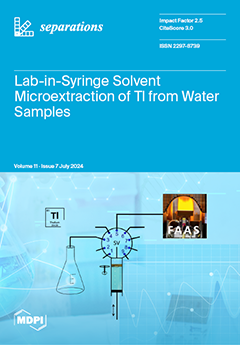The chemical composition of
Sedum ewersii Ledeb., a plant indigenous to Kazakhstan and traditionally utilized in folk medicine, was comprehensively investigated, with a focus on its various plant parts. Fresh samples collected in May 2023 from the Almaty region underwent hydrodistillation to extract
[...] Read more.
The chemical composition of
Sedum ewersii Ledeb., a plant indigenous to Kazakhstan and traditionally utilized in folk medicine, was comprehensively investigated, with a focus on its various plant parts. Fresh samples collected in May 2023 from the Almaty region underwent hydrodistillation to extract volatile components, followed by analysis using gas chromatography coupled with mass spectrometric detection, which identified a total of 71 compounds across different plant parts, including the root (underground part), root (aerial part), leaf, stem, and flowering aerial part. The predominant biologically active compound identified across all plant parts was Ethyl α-D-glucopyranoside. Monoterpenes, recognized as primary secondary metabolites, were notably abundant in each plant part, with varying compositions: the root (underground part) contained 28.58% aliphatic monoterpenes, 54.41% oxygenated monoterpenoids, 1.42% diterpenoids, and 15.59% other compounds; the root (aerial part) exhibited 1.34% aliphatic monoterpenes, 31.28% oxygenated monoterpenoids, 6.16% diterpenoids, and 61.22% other compounds; the stem and leaves showed 3.06% aliphatic monoterpenes, 21.49% oxygenated monoterpenoids, 17.99% diterpenoids, and 57.46% other compounds; and the flowering aerial part displayed 8.20% aliphatic monoterpenes, 53.18% oxygenated monoterpenoids, 23.75% diterpenoids, and 14.87% other compounds. Diterpenes, particularly Phytol, were prominently present in the leaf, stem, and flowering aerial parts. Additionally, a diverse array of organic acids, ketones, and phenolic compounds were identified across the plant parts, each potentially offering distinct pharmacological benefits. The presence of exclusive compounds in specific plant parts, such as Dihydroxyacetone in the root (aerial part), underscored the pharmacological diversity of
S. ewersii. This study provides valuable insights into the chemical diversity and pharmacological potential of
S. ewersii, suggesting promising applications in pharmaceutical and medicinal fields. Further research aimed at elucidating the individual and synergistic pharmacological effects of these compounds is crucial to fully harness the therapeutic benefits of this plant.
Full article





